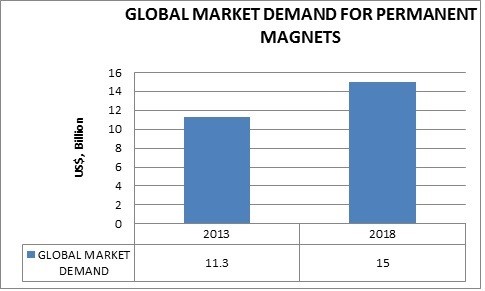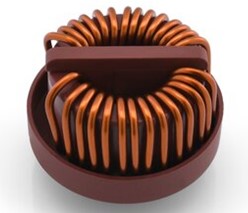By Roman Klinger and Dr. Johannes Beichler – VAC
In recent years, innovative soft magnetic materials have moved to the forefront of electrical engineering and electronics and led to the development of many advanced components. Today, Vacuumschmelze (VAC) produces an array of high-quality soft magnetic alloys and advanced alloy products for a wide range of applications, including installation technology (e.g. electronic electricity meters) and renewable energies (solar, wind) to modern consumer products (computers, flat screen TVs). Although VAC’s contributions are usually concealed within the finished product, they fulfill important functions such as device and personal protection, billing processes accurate to the last cent, low-loss energy transmission and the interference-free operation of electronic devices.

Toroidal tape-wound cores made from the nanocrystalline alloy Vitroperm have a proven track record in common-mode chokes (CMCs) for the interference suppression for electronic devices. The properties of Vitroperm CMCs enable high attenuation at low-frequency ranges and improved high-frequency (HF) attenuation.
Compared to chokes made with ferrite cores, the broadband interference suppression, coupled with improved thermal properties, delivers significant advantages in filter design and enables the production of highly reliable EMI filters. In certain conditions, intelligent filter configuration enables single-stage filters to be used instead of two-stage filters, hence reducing the number of passive components, system costs and component dimensions.

Vitroperm has already established itself in a wide range of applications as a universal solution for EMC problems through its use of low-cost alloy constituents (Fe-based) and modern large-scale production lines. Key applications for nanocrystalline CMCs are switched-mode power supplies, uninterruptable power supplies, welding equipment, photo-voltaic solar inverters, wind generators, electric and hybrid cars and frequency converters.
Nanocrystalline Vitroperm alloys are based on Fe, Si and B with Nb and Cu additions. Using rapid solidification technology, thin tapes or ribbons approximately 20 µm thick are produced from these alloys in a single process step.

Special winding machines are used to produce tape-wound cores from these ribbons, with external diameters ranging from 2 mm to 600 mm. The cores then undergo a heat treatment at 500°C to 600°C while still in an amorphous state, to form the nanocrystalline microstructure. This process results in a two-phase structure in which fine crystalline grains (average grain size 10 to 40 nm) are embedded in an amorphous residual phase. This characteristic structure maximises the permeability µ and minimizes the coercivity Hc. In addition, the low tape thickness and relatively high electrical resistivity of 1.1 to 1.2 µΩm ensures minimal eddy current losses and outstanding frequency response for the core. As a high-tech nanocrystalline soft magnetic alloy, Vitroperm combines these properties with a saturation flux density of 1.2 T and favorable thermal characteristics. It thus represents a universal solution to EMC problems which, in many aspects, is superior to conventional ferrites and amorphous materials.

Vitroperm vs. Ferrite
The properties of Vitroperm differ widely from those of conventional ferrites. This must be considered in filter design if optimum solutions are to be achieved. In low-frequency ranges the permeability of Vitroperm 500F is higher than that of ferrite. Nanocrystalline materials show a less marked reduction of permeability µ at higher frequencies. μ(f) of ferrites shows a flat characteristic over a range from several hundred kHz to approximately 1 MHz, dependent on the initial µ-value. In this flat range, attenuation properties are determined by the real part of the complex permeability μ’ and the absolute value of the impedance |Z| is dominated by the inductance L. If the self-resonance of the choke is within this frequency range, the attenuation characteristic is narrowband and attenuation is primarily caused by reflection of the interference signal. The attenuation of ferrites is determined by its resistive parameters at frequencies above the flat range mentioned above because the real part of the impedance Re(Z) account for the major share of the attenuation and the imaginary part of the complex permeability μ’’ becomes the dominant factor. If the self-resonance of the choke is in this range then the attenuation curve becomes increasingly broadband.

The flat sector of µ(f) of Vitroperm 500F only extends up to frequencies of several tens of kHz, depending on the individual permeability level. Consequently, at higher frequencies the attenuation (or |Z|) is already dominated by µ’’, respectively Re(Z) and is always broadband in the whole EMC-relevant range above 150 kHz. Inductance plays a minor role and only partially influences the attenuation. The determining factor is the total impedance. The approximation |Z|=ωL is invalid for Vitroperm chokes, to which |Z|>>ωL applies. Attenuation does not primarily result from a reflection of the interference signal, but from its absorption.

High impedance is achieved more effectively by using a highly permeable core material, rather than by increasing the number of turns, since a low number of turns corresponds to a low winding capacitance and thus superior HF properties. Vacuumschmelze has focused on the favorable material properties of nanocrystalline cores to build extensive practical and theoretical experience in the design of common-mode chokes and filters. Using identical material, VAC’s optimized chokes with low winding capacitance achieve significantly better high-frequency properties.
Thermal Properties
The saturation flux density of Vitroperm decreases by less than 5 to 10 percent in the operating temperature range of up to 150°C, while MnZn ferrites declines by up to 40 percent at temperatures approaching 100°C. Vitroperm alloys have a high Curie temperature of more than 600°C, temporarily allowing maximum operating temperatures as high as 180°C to 200°C. The insertion loss (and impedance) of a CMC made of Vitroperm 500F is practically temperature-independent over a temperature range of -40°C to above 150°C. In contrast, ferrite chokes show a significant drop in insertion loss at increasing temperatures.

Saturation Behavior
High inductance levels in extremely compact cores or chokes increase the sensitivity to asymmetric magnetization conditions caused by common-mode, unbalanced or leakage currents. The saturation flux density of Vitroperm of 1.2 T has the advantage of being approximately three times higher than that of ferrites but a suitable µ level has to be selected very carefully to find the optimum saturation-resistant solution. High permeability Vitroperm cores are characterized by a high impedance at low frequencies and they are clearly superior against ferrites at high frequencies. However, the price of this superior performance is a more sensitive saturation behavior, which increases with increasing frequency but is still more critical than that of other low µ core materials.
The material properties of nanocrystalline core materials enable the production of common-mode chokes with high inductance and an extremely low number of turns. Vitroperm cores and chokes are thus equally suitable for high currents and high voltages.
Literature
[1] Petzold, J. ‘Applications of nanocrystalline soft magnetic cores in modern electronics’; Soft Magnetic Materials 16 (09.-12.09.2003), Vol. 1, p. 97
[2] Klinger R., ‘Nanocrystalline VITROPERM / EMC products’; Beichler, J. Vacuumschmelze GmbH & Co KG, product brochure 2010
[3] Petzold, J., ‘Nanocrystalline materials in common-mode chokes’; Klinger, R. PCIM Europe 6/2000
[4] Petzold, J. ‘Nanokristalline Kernwerkstoffe in stromkompensierten Klinger, R. Funkentstördrosseln’; EMC Kompendium 2001, p. 148
[5] Beichler, J. ‘Designvorteile durch nanokristalline Kerne’ E&E Kompendium 2005/2006, p. 112
[6] Kvarnsjoe, L. ‘Green Inductive Components’; Power Systems Design Europe June 2009.
For more information visit www.vacuumschmelze.com.



